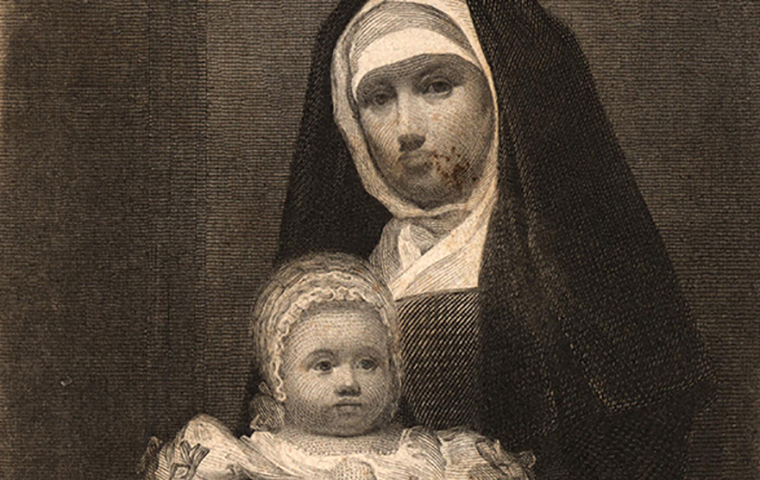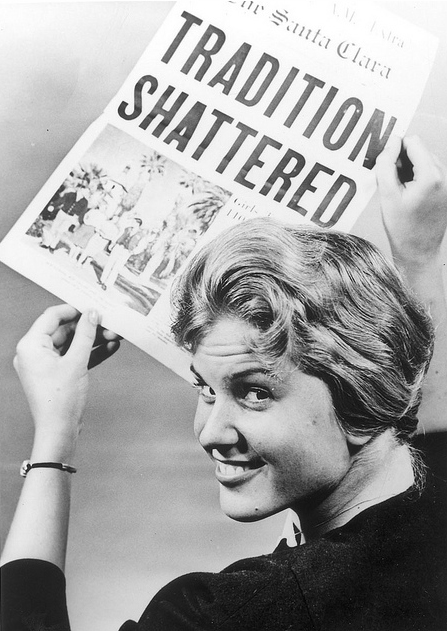
History Repeating
Students and faculty turn to the library archives to explore the continued fight for gender equality, 19th Century “Fake News,” and the case for Frankenstein and the canon.
Fifty-seven years ago, when Santa Clara University formally opened its classrooms to female students, the campus newspaper’s front-page headline captured the moment with the words “Tradition Shattered.” But the women who enrolled at SCU in the fall of 1961 added more than a new presence; their voices generated both pushback and progress, forcing a consideration of women’s needs and interests that continues to this day.
Their powerful story is just one element of the exhibit “Undergrads in the Archives: Analog | Digital,” which was featured at this past spring’s feminist themed digital humanities showcase co-sponsored by the English Department and Archives & Special Collections. The intriguing three-part exploration of feminism in local, national, and international history—through a variety of media—is on display through Sept. 16 in the third floor gallery at the University Library.
The displays, featuring digital and physical exhibits, was curated by faculty and undergraduates in three English classes, and coordinated with Nadia Nasr, head of SCU’s Archives & Special Collections. For many of these undergraduates, it also marked the first time that they had ever used archival material in their research.
Beyond the well-documented history of women’s evolving roles at SCU, the exhibit also focuses on rare editions of two literary works that galvanized readers in their day, including the exploitation by Maria Monk, a female author whose incendiary 1836 autobiography—which was never corroborated—chronicled the alleged sexual abuse of nuns in Montreal by Catholic priests; and the bicentennial celebration of Mary Shelley’s 1818 gothic novel Frankenstein or Prometheus Unbound.
Back in the Day
To explore the evolving roles of women at SCU, Nasr helped the students locate materials showing that even before 1961, women were allowed to take classes at SCU. They did so in various certificate and nursing programs, alongside the same men who would later claim their all-male “tradition” had been “shattered” by the women’s matriculation.
Historical documents reveal that SCU’s watershed co-ed moment wasn’t as much the sudden inclusion of women on campus, but the accompanying regulations and resistance that developed in response to their presence.

Under the guidance of Amy J. Lueck, assistant professor of rhetoric and writing studies, students Tierra Abeyta ’21, Mara Cassin ’19, and Mara Strong ’20 uncovered examples of the challenges many women faced upon their arrival at SCU. Materials detailed the “proper Santa Clara woman’s” attire and dating behavior, and the student government’s decision to seat women in a separate section at sporting games.
These stipulations were not silently accepted; archival materials also show women’s groups on campus rising up and holding lectures on “assertiveness for women.”
Brochures and pamphlets at that time sought to protect women from sexual harassment. Beyond that, a campus women’s center was formed to address the many other issues facing the new students. While the center no longer exists, a flourishing women’s and gender studies department does.
Despite the progress women have made at SCU, and the protections guaranteed under Title IX, the 1972 federal law that prohibits gender discrimination at any federally funded school or program, Lueck believes gender parity has a long way to go.
“We cannot just sit down and pat ourselves on the back and say ‘done, we did it,’’’ she said.
Fake News
The term Fake News might have been coined and popularized in the last two years, but the practice of writing and reporting that emphasizes sensationalism over facts isn’t a new creation. Note the bestselling 19th century book The Awful Disclosures of Maria Monk.
The so-called “convent narrative’’ by a young woman named Maria Monk claimed she had lived in a convent in Montreal where she witnessed priests’ sexual abuse of nuns and repeated infanticide.
While there was never any evidence of the alleged crimes, the book sold at least 300,000 copies prior to the Civil War—probably the most widely read contemporary book in the U.S. before Uncle Tom’s Cabin, according to one historian.
Beyond the salacious nature of sexual encounters described in the narrative, scholars say the book’s popularity stemmed from the influx of immigrants into the U.S., particularly Catholic immigrants.
“There was a heightened awareness of Catholicism overall,’’ said Nasr, “and its presence was perceived by American Protestants to be very threatening.”
It was also pure propaganda, said SCU English Professor Michelle Burnham, who along with Natalie Linnell, an SCU math and computer science lecturer, was involved in the student project.
“It’s 19th century fake news,’’ said Burnham. “It’s coming out of an anti-immigrant context that is aimed at a much different population than it is today, but is still part of this nativist, political sensibility that we are now experiencing again.”
Maria Monk actually existed, and is credited as the author of many editions of the book, but research reveals that some of the publishers involved in the editing process were Protestants who helped her write her story.
Burnham surmises that Protestants may have selected Monk to write her sordid tale because “she was pliable, and maybe desperate for whatever they offered her.’’

She Creates
Unlike Maria Monk’s narrative, Frankenstein is among the best known novels in the English language. Yet Mary Shelley—who was the daughter of a feminist, and the woman behind the fictional Dr. Frankenstein and his monster—is rarely discussed.
Assistant professor of English Kirstyn Leuner’s students sought to change that in a display that celebrates the bicentennial anniversary of the novel—in various formats—and its progressive female author.
Shelley, after all, is one of the few women in the “literary canon’’—books or text considered to be among the most important and influential in a particular time.
“The canon gives you star power,’’ Leuner said, “You’ll find that there are many subsequent editions of a text that are canonical; authors will take the work and make entirely new works of art out of it—like all the Frankenstein movies we have today.’’
Leuner believes that the novel’s cultural relevance makes knowing Frankenstein as important as knowing Hamlet, which means knowing about Mary Shelley is as important as knowing about William Shakespeare. That’s because women writers—especially early women writers—“have had a rough road to being included in the literary canon,” she said.
The gothic nature of Frankenstein, filled with science and technology, also was not a common theme used by female writers. To Leuner, Shelley was “a pioneer traversing into traditionally masculine subjects.’’
A fictionalized engraving of Maria Monk holding a baby.